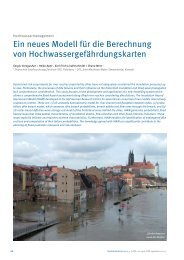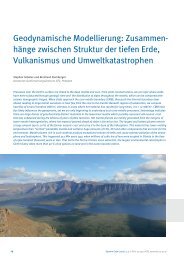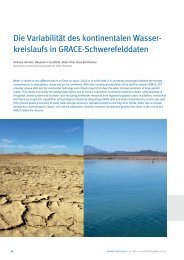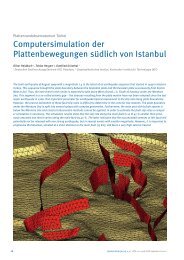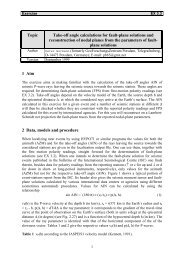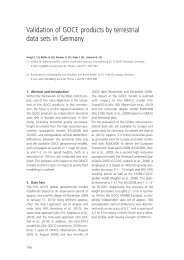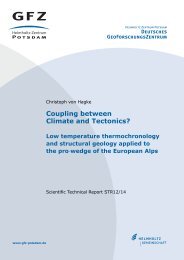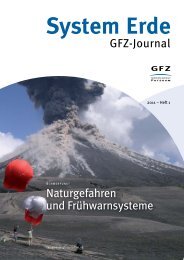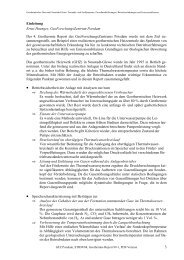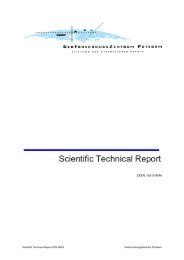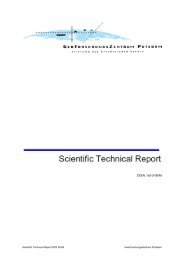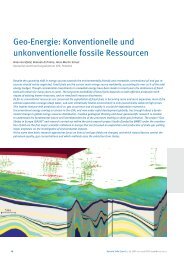2 Seismic Wave Propagation and Earth models
2 Seismic Wave Propagation and Earth models
2 Seismic Wave Propagation and Earth models
Create successful ePaper yourself
Turn your PDF publications into a flip-book with our unique Google optimized e-Paper software.
2. <strong>Seismic</strong> <strong>Wave</strong> <strong>Propagation</strong> <strong>and</strong> <strong>Earth</strong> <strong>models</strong><br />
A 0<br />
A = n<br />
x<br />
ω t<br />
−<br />
2 Q<br />
e<br />
=<br />
A<br />
x<br />
38<br />
π x<br />
−<br />
0 Q T v<br />
e n<br />
=<br />
A −<br />
x<br />
0 e n<br />
ω x<br />
2Q<br />
v<br />
, (2.31)<br />
with A0/x n – the geometrical spreading term, exp(-x t/2Q) = exp(- π/Q T v) the attenuation<br />
term, ω - angular frequency 2π /T, T – period of wave, t – travel time, v – propagation<br />
velocity of wave, <strong>and</strong> n – exponential factor controlled by the kind of geometric spreading.<br />
According to experimental data, n varies between about 0.3 <strong>and</strong> 3, depending also on the type<br />
of seismic wave <strong>and</strong> distance range considered.<br />
In ray theoretical methods, attenuation may be modeled through the use of the parameter t *<br />
that is defined as the integrated value of the travel time divided by 1/Q<br />
* dt<br />
t = ∫ , (2.32)<br />
path →<br />
Q( r )<br />
where →<br />
r is the position vector. We can then write Eq. (2.31) as<br />
A(ω) = A0(ω) e -ω t*/2 . (2.33)<br />
Note, that P-wave attenuation Qα <strong>and</strong> S-wave attenuation Qβ differ. They are related to the<br />
shear attenuation Qμ <strong>and</strong> the bulk attenuation Qκ by the relationships<br />
Qβ = Qμ <strong>and</strong> 1/Qα = 4(β/α) 2 /3Qμ + [1 - 4(β/α) 2 /3]/Qκ. (2.34)<br />
with P-wave velocity α = vp <strong>and</strong> S-wave velocity β = vs. In the <strong>Earth</strong> shear attenuation is<br />
much stronger than bulk attenuation. While Qμ is smallest (<strong>and</strong> thus shear attenuation<br />
strongest) in the upper mantle <strong>and</strong> the inner core, Qκ is generally assumed to be infinite,<br />
except in the inner core. While the P- <strong>and</strong> S-wave velocities are rather well known <strong>and</strong> do not<br />
differ much between different <strong>Earth</strong> <strong>models</strong>, the various model assumptions with respect to<br />
Qα <strong>and</strong> Qβ as a function of depth still differ significantly (see Fig. 2.53). According to the<br />
PREM model, Qμ is 600 for less than 80 km depth. It then drops between 80 <strong>and</strong> 220 km to<br />
80, increases to 143 from 220 to 670 km, <strong>and</strong> is 312 for the lower mantle below 670 km<br />
depth.<br />
In practice, it is difficult to separate intrinsic attenuation <strong>and</strong> scattering Q. Particularly in local<br />
earthquake records, which are strongly affected by scattering on crustal inhomogeneities,<br />
scattering Q dominates. Scattering Q is usually determined from the decay of coda waves<br />
following Sg (SmS) onsets (e.g., Fig. 2.40) <strong>and</strong> is called accordingly Qc. A full discussion on<br />
these topics can be found,e.g., in Aki <strong>and</strong> Richards (1980; pp. 170-182).<br />
In this context it should be mentioned that amplitudes of S waves are generally about five<br />
times larger than those of P waves (see Fig. 2.3). This follows directly from Eq. (3.2) in<br />
Chapter 3 or from the far-field term of the Green’s function when modeling earthquake shear<br />
sources (see Equation (24) in the IS 3.1) taking into account that vP ≈ vS √3 (see this Chapter,<br />
Eq. (2.9)). Also, the periods of S waves are longer than those of P waves, again by at least a<br />
factor of √3, due to the differences in wave propagation velocity <strong>and</strong> the related differences in<br />
the corner frequencies of the P- <strong>and</strong> S-wave source spectrum. Additionally, S waves are much<br />
stronger attenuated than P waves (see following section), thus filtering out higher frequencies<br />
more strongly. It should also be noted that S waves do not propagate in the fluid outer core



